Along with his self-built guitar, this white Nik Huber Krautster was one of the main guitars Scott Middleton used on the Cancer Bats new album, Searching for Zero. Photo by Igor Vidyashev / Atlas Icons
Cancer Bats are a hardcore thrash-metal band from Toronto. The focal point of their all-out aural assault is the riff-heavy, pick-squealing, low-tuned playing of sole guitarist Scott Middleton. But for all the Cancer Bats’ unrestrained energy and audience mayhem, Middleton is no guitar-smashing punk. He travels the world with an arsenal of high-end gear and a seemingly endless supply of boutique effects. And his tone is righteous.
Middleton started playing guitar at 11. “I bought Metallica’s Black Album and just loved every song,” he recalls. “I decided, ‘I need to buy a guitar.’” He convinced his father to get him a cheap SG knockoff a neighbor was selling. “The guy threw in a Rolling Stones songbook, and that was the clincher,” says Middleton. “My dad is a Stones fan.”
Middleton and lead singer Liam Cormier started Cancer Bats in 2004. They toured North America nonstop and settled on their current lineup (with Mike Peters on drums and Jaye Schwarzer on bass) after recording their second album, Hail Destroyer, in 2008. It was a watershed album, earning top reviews in the metal press, millions of YouTube views, and a 2009 Juno nomination for New Group of the Year. (The Junos are Canada’s Grammys.)
But Cancer Bats don’t rest on their laurels. After recording four albums with the production team of Kenny Luong and Eric Ratz, last summer they tried something new and hired legendary nü metal producer Ross Robinson (Korn, Limp Bizkit) to record their fifth album, Searching for Zero. The album continues in the heavy tradition, but breaks new ground, thanks in part to the influence of the band’s alter-ego: Bat Sabbath, a Black Sabbath cover band. “We did a double headlining tour playing an hour of Cancer Bats and then an hour of Black Sabbath covers,” says Middleton. “We co-headlined with ourselves.”
Middleton is also a gear fiend. He loves to tinker with new equipment and spends days in the studio sculpting sounds and nerding out with gear. He has close relationships with various guitar, amp, and stompbox manufacturers. Just don’t ask him to play a 7-string. “Guitars have six strings,” he states. “Anything more than six strings is a harp as far as I’m concerned.”
PG caught up with Middleton to discuss working with Ross Robinson, the quest for the ultimate guitar, studying lutherie in Spain, and Middleton’s globe-trotting search for cool boutique gear.
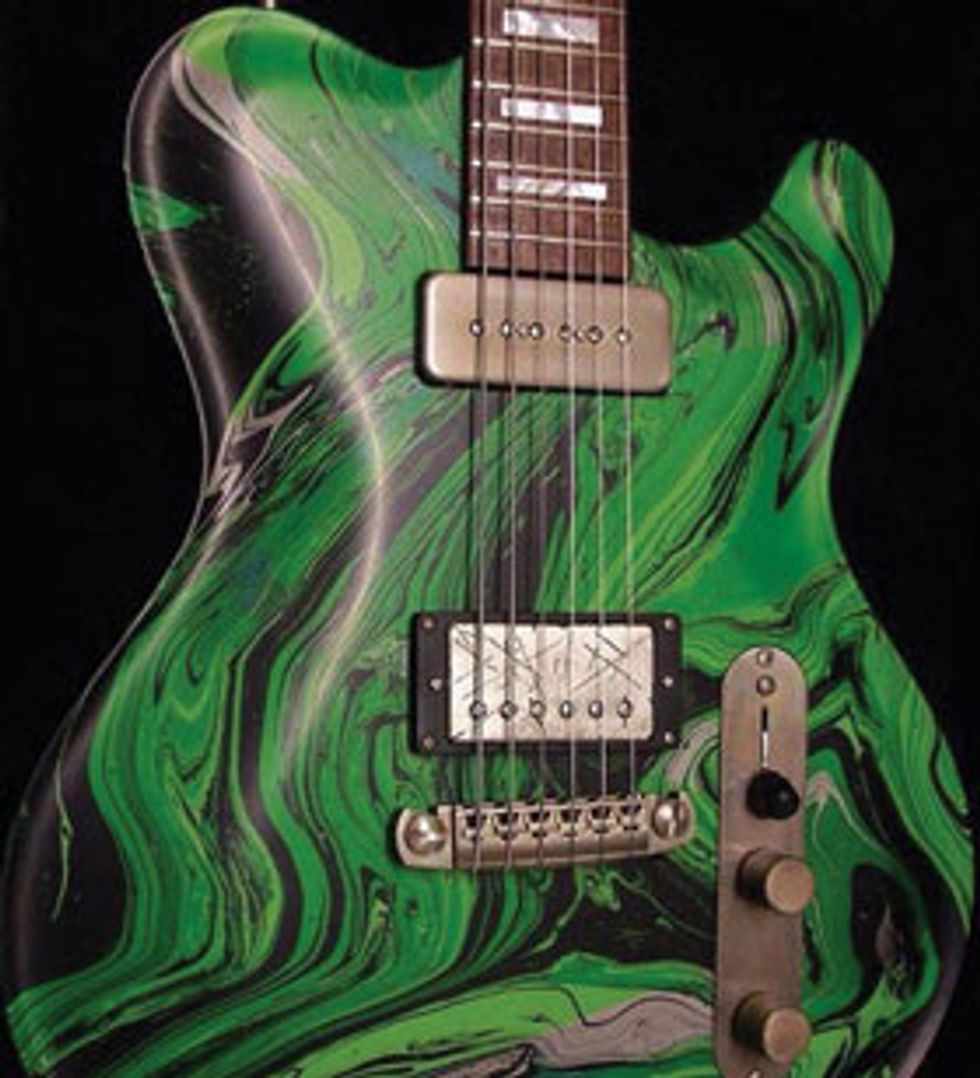
Middleton calls his latest Nik Huber guitar the Das Grüne Omen—the Green Omen. It’s based on Huber’s Twangmeister model and has a T-style body, carved top, and rosewood neck and fretboard.
Did you tour like crazy in the early days?
Pretty much our whole career. We come from the hardcore punk scene and that whole DIY ethic. We weren’t thinking about big labels or tour support or any of that stuff. It was just natural for us to start bands, record our own demos, make our own merchandize, tour in a van, and just go and go and go. When things started happening and we got all these opportunities, we said yes to every single one of them. We made sure that we didn’t have time to work jobs. We made the band our life and toured 200 to 300 days a year. Once we broke into Europe we were playing even more, and that opened up this whole world for us. When you’re an independent band starting out, you have to get out to people. That’s how you push yourselves on new audiences. And it’s how you make your living, too.
You have great tone. How do you achieve it, and what do you do to distinguish your sounds between songs?
For our first four albums the one constant was my Diezel Herbert amp. I also used, starting with Hail Destroyer, [Canadian-made] Morris Amps. Glen Morris is a great guy, a local builder who’s been repairing and modding my amps since I was quite a bit younger. He does all his stuff point-to-point, and he can sit with me and customize the sound coming out of the amp. He made something that complemented my Diezel perfectly. We would record both amps together and occasionally add a third amp on top for a little sprinkling of special sauce, or whatever.To differentiate tones, we audition many guitars. I would have five or six guitars with me in the studio, and we’d do a pass of the main riff with each one. Then we would blindly listen and see which one felt best in the track.
That must take a lot of time when you’re recording.
Yeah, that’s how we did the first four albums. Our new album with Ross Robinson was a bit different, though we still tried different guitars. I have a guitar collection now, and each guitar makes me want to write a different kind of song. I play differently on certain guitars. Now I know what the go-to guitar should be about half the time.
Middleton and the rest of the Cancer Bats in the studio with producer Ross Robinson. Photo by Vince Edwards.
What was it like working with Ross?
We didn’t know what to expect because we’d heard all these stories about him going crazy on bands in the studio and making people freak out and cry. Some of our friends were warning us: “I don’t know if you guys will be able to handle this. You’re all such nice dudes. Maybe he’ll break you guys up.” But our managers were really into the idea, and we were positive about it, too. Ross has worked with so many cool bands. He also worked with bands we don’t like, but we could step back and recognize that Ross probably made their best records. Once we spoke to him on the phone, got a vibe, and sent him demos, we knew he was the guy. Now he’s one of our closest friends.
I’ve never met a guy so instantly inspired by any music that he hears. He hears something and says, “That’s so cool—why don’t we try it like this?” He fires ideas so quickly, and so many of them are good. Everything is so spontaneous. He’s also into making music that means something. We were in this tiny room recording drums, and he’d say, “Okay, Liam, before we record drums, tell us what the song is about.” If Liam said something that was kind of vague, he would call bullshit and ask, “No, what’s it really about?” He really gets into the psychology side of things. He’d ask me, “Okay, Scott, what does this mean to you? How does this make you feel? Why are you playing this song?” He would go through every band member, and everybody had a powerful story. Ross’ whole idea is that it's not just the singer singing the song—everybody sings the song with their instruments. If you’re only concentrating on playing and not putting your feelings into it, it’s just sterile bullshit.
Scott Middleton's Gear
Guitars
Nik Huber Twangmeister (“Das Grüne Omen”)
Nik Huber white Krautster
Nik Huber Green “Arsenal” Orca
Nik Huber Hollowbody Orca
The guitar Middleton hand-built at the Formentera Guitar School
Pickups
Fastback Unshaven Beard Combers
EMG 57/66
EMG 81s
Häussel Tozz B XL
Häussel P90 Vintage
Amps
Diezel Herbert
Diezel Lil’ Fokker
Morris XSIII
Diezel 4x12 cabinet
Krych 4x12 cabinet
Celestion Vintage 30 speakers
Effects
Rocktron Guitar Silencer
ISP Decimator G-String
Providence PEC-2
Cusack Pedal Board Tamer
Planet Waves Chromatic Strobe Tuner
Morley Bad Horsie Wah
Electro-Harmonix POG2
EarthQuaker Devices Dispatch Master
Strymon TimeLine
TC Electronic Flashback Delay
Empress Nebulus
Empress Heavy
Empress Compressor
Empress Multidrive
Providence Velvet Comp
Providence Chrono Delay
Tym Effects Fuzz Munchkin
Klon KTR
Cusack Screamer Fuzz (scruzz version)
Neunaber Wet Stereo Reverb
Valco The Stooge
Jam Pedals Multi-Pedal
Cioks DC10
Strings and Picks
GHS Low-Tuned Boomers .011–.053, tuned to dropped C (C–G–C–F–A–D). Middleton sometimes uses a .056 for the 6th string.
Purple Planet Waves Duralin picks (1.2 mm)
ChickenPicks (2.6 mm)
Schaller strap locks
Schaller locking tuners
GHS Fast Fret
Planet Waves straps
Providence, Planet Waves, and American Stage cables
Do you use your live rig in the studio?
Yeah, though on this record I used a prototype Diezel head, the Lil’ Fokker, because I couldn’t bring my rig down to Venice Beach where we recorded. Also, Ross has an old AC30 that we ran pedals into. The pedal that was on most was the new Klon KTR. Those things together just had a great sound. And the way Ross works, we would find the tone we were looking for, and then he would say, “Give me a take—let’s go!” I’m still deciding if I like the sound, but Ross is already 100 percent sure it’s the sound. I’m thinking we should do it again, but he’s like, “No, you played badass, man.” He’ll let me try it again, but when I play it one more time, he starts throwing shit at me. He grabbed a spindle of CDs and threw CDs. I’m thinking, “What are you doing, man? I’m fucking up.” But he’s like, “It’s awesome!” Because for Ross, mistakes are cool. He wants you to fuck up, because after you make a mistake, the next thing you play is going to be naturally inspired. You’ll play something weird. That’s how you catch something special.
So he kept you on your toes?
He’d say, “Okay, cool—we got the rippin’ metal heavy stuff. Now let’s see what the song sounds like when you play a Rickenbacker clean.” There was a vintage Rickenbacker lying around the studio that belonged to [Limp Bizkit’s] Wes Borland. Ross said, “Normally you play downstrokes on this part, right? Now make the equivalent chord, but only use the high strings and play it all upstrokes, like you’re in a reggae band.” We put that in a straight-up thrash-metal song called “All Hail”—a tribute to Dave Brockie from Gwar, who just passed away.
It sounds like you’re playing weird harmonics. Is that the Rickenbacker?
Yes. Ross was screaming, “Hit it fucking harder! Hit it harder!” I don’t know how we’re going to do that live, but it sounds super rad on the album.
You have many fuzz boxes. Do you get distortion mostly from the amp or from effects?
In the studio, 90 percent of the time it’s the amp. All the effects are just for color. When I used the Klon, it gives me the extra juice I need to play metal on an AC30.
Do you use a noise gate?
I use two, actually. In the effects loop of my amp I use the ISP Decimator G-String pedal. In front of my pedalboard I use the Rocktron Guitar Silencer. I could get by with just one, but the two totally kill hiss and hum.
You don’t solo much. Is that a conscious thing? It’s obvious you have chops.
For me, playing riffs is just as awesome as soloing. There can be just as much virtuosity in rhythm playing. I love listening to guys who can take solos to places I can’t, but I don’t think every song requires a solo. Not everybody listening to your band is a guitar player, and maybe they don’t like the indulgent guitar wanking. [Laughs.] And as the one guitar player in the band, if I do a solo, I want to be able to pull it off live, where I don’t have a rhythm guitar track underneath it.
“To start with blocks of wood and then build an instrument that you write songs with is such a cool feeling,” says Scott Middleton about this guitar he built at Formentera Guitar School.
Do you play the same solos every time or do you improvise?
Of course, you’re going to ad lib stuff live. A lot of solos are recorded in a spontaneous way. But I’m spending more time mapping out solos. I’m becoming more prepared.
You’ve had a lot of guitars over the years. Have you found the one yet?
I’ve been playing Nik Huber guitars. About four years ago when we were doing Dead Set on Living, I was looking for a new guitar. Every time we make a new record, I want to get a new guitar. A new instrument inspires me. When I have writer’s block, I put a new instrument in my hands, and it’s like magic—songs just want to come out of it. I ended up buying one of Nik’s guitars, one called the Krautster. It looks almost like a Les Paul Jr., with a single humbucker. That guitar made Dead Set on Living. It’s a classically styled guitar but with modern features, really well built, really good wood and attention to detail. It feels like somebody made it, as opposed to it just coming off a factory line. Since then I’ve become good friends with Nik and his crew. They’ve made me two guitars. I have a green one called the Orca. We were playing the main stage at the Reading Festival in England for the first time [in 2012], and they gave it to me as a gift. I played it that day. They knew what I liked, and Nik was already building my favorite guitar.
That led to a discussion at the Montreal Guitar show. Nik was part of the expo, and I drove up to hang out and talk about guitars. He got into being a luthier after taking a course on Formentera, a tiny island off the coast of Spain. He hooked me up with a contact, and Clemens Huber, Nik’s right-hand man (they aren’t related) and I booked a trip. We went there last summer and took the guitar-building course together. So I made my own guitar. I have a B.B. King Lucille that I love, but it’s not great for playing live. I wanted to build a guitar that could have that style, but also nail the heavy, tight stuff. I spent a month in Spain building that guitar, and the guitar ended up writing half the songs on the new album.
Is that your main ax now?
It’s one of them. My flight case can’t fit the guitar I made, so I just bring Nik’s guitars to Europe.
Did you make everything on your guitar?
I didn’t build the hardware, but I wound the pickups. When I save up some money to buy tools, I want to set up a shop and start building and selling guitars, because I had such a great time doing it. I was expecting to make a guitar that I would hate, but when I plugged it in, I thought, “This is crazy—it sounds so good, and I love it.” To start with blocks of wood and then build an instrument that you write songs with is such a cool feeling.
Do you have a name for your future company?
Scoebcity Shred Sticks! [Laughs]. We’ll see if that sticks. My guitar was one of the main guitars on the album—that and my white Nik Huber Krautster. Just before the album was recorded, Ryan “Fluff” Bruce sent me his signature pickup, the Beard Comber, made by a company called Fastback Guitars. I put it in my Krautster because I just wanted something different—three of my Huber guitars have the same pickup. Ross heard that guitar and was like, “Holy shit—that’s the best sound ever!” Nik just built me a new guitar based on his Twangmeister model, with a Tele-style body and a carved top. The whole neck is rosewood. The fingerboard is rosewood, too, and the body is solid mahogany. I plugged it in and I was just grinning huge. I think this is going to be the one. We call it Das Grüne Omen—the Green Omen.
YouTube It
Hear Scott Middleton’s blistering riffs in “Satellites” from Cancer Bats latest album,
Searching for Zero.
There are a ridiculous number of metal sub-genres. What is Cancer Bats?
It’s so funny with our band. We play for some people, and they say, “You’re my favorite punk band.” And we’re like, “We’re a punk band?” Then we tour with a punk band, and it’s, “You are the coolest metal band I’ve heard in a long time.” That’s awesome—we’ll take that! I don’t really care. We have this ridiculous name, Cancer Bats, because when Liam suggested we start a band called Cancer Bats I thought, “I don’t care about the meaning behind that—it just sounds like a badass heavy rock band.” You know it’s not going to be something wimpy.
Middleton's North American pedalboard.
Pedals Galore
“One thing I love about touring around the world,” says Scott Middleton, “is going to the cool local guitar shops and finding pedals made by the local guy.”
During an Australian tour, for example, Middleton got friendly enough with Tim Brennan of Brisbane’s Tym Guitars to acquire the rare and coveted J Mascis signature Fuzz Munchkin. After a show in Greece, he discovered Jam Pedals in Athens and bought their hand-painted, vintage-style Multi-Pedal. Canadian-based Empress Effects had him beta test their Heavy distortion. The list goes on.
Middleton's European pedalboard.
Middleton has two pedalboards: one in North America and one in Europe. Both boards start with programmable switching systems. In North America he has a Providence PEC-2, and in Europe he uses a Cusack Pedal Board Tamer. He prefers the Planet Waves Chromatic Strobe Tuner, and his wah of choice is Morley’s Steve Vai-signature Bad Horsie. He uses the Electro-Harmonix POG2, EarthQuaker Devices’ Dispatch Master, a Strymon TimeLine, and a Rocktron Guitar Silencer. He powers it with a Cioks DC10, and mounts it on a Pedaltrain Pro. He is checking out the TC Electronic Flashback Delay and is enjoying the Empress Nebulus and the Neunaber Wet Stereo Reverb.
And then there’s fuzz. Besides the Tym Effects Fuzz Munchkin, Middleton has an Empress Effects Multidrive, a Klon KTR, and Cusack Screamer Fuzz—and he loves them all. “I’ve got millions of pedals,” he says.



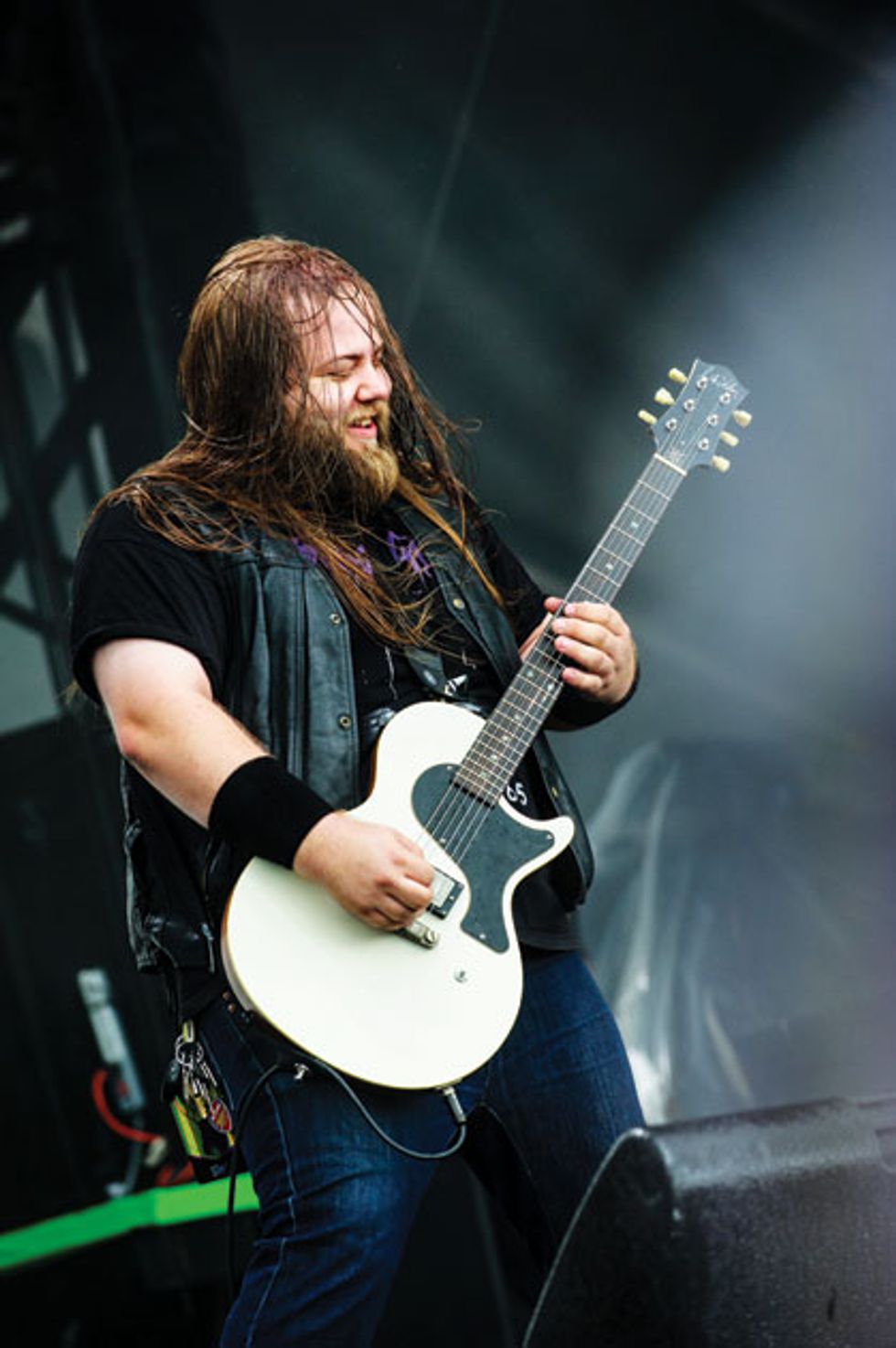
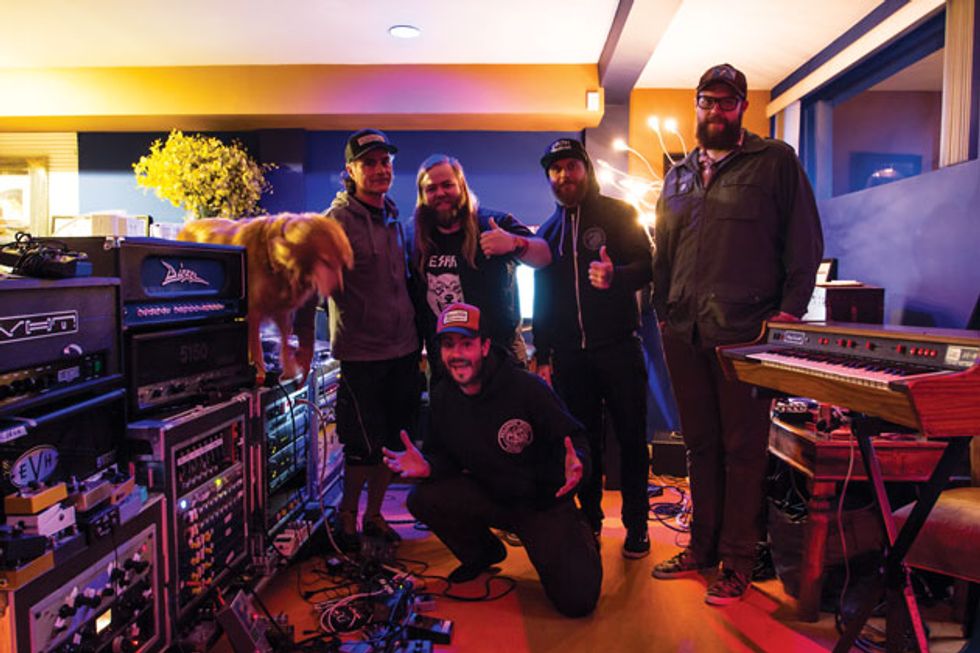
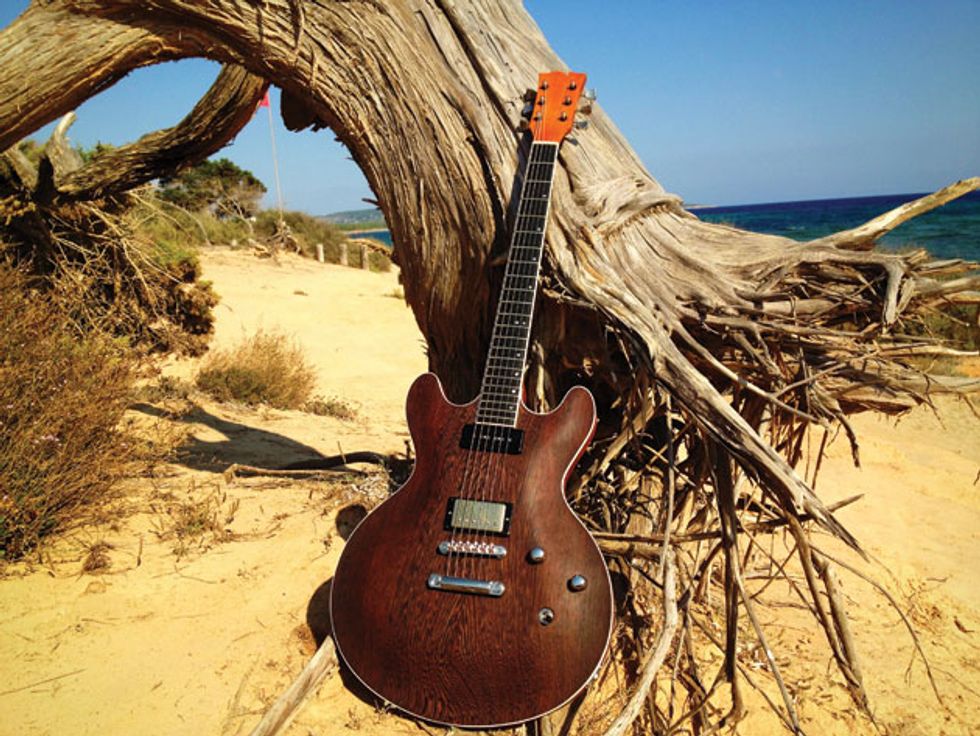
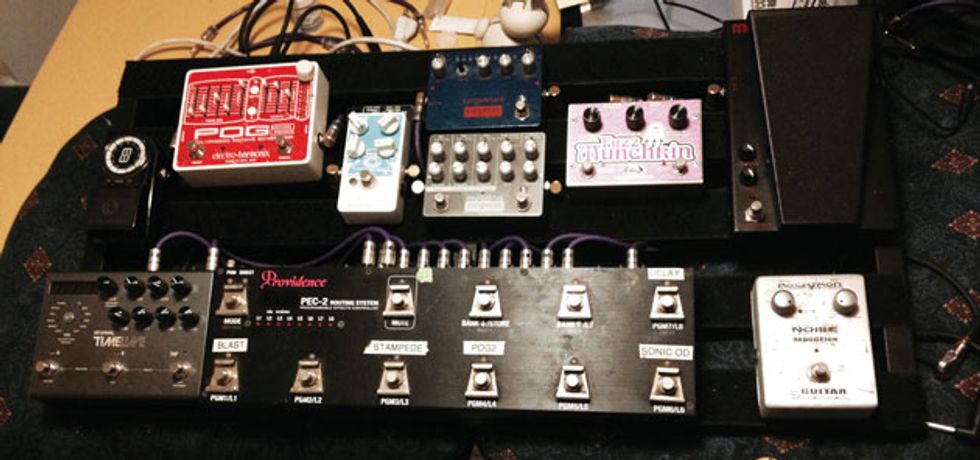
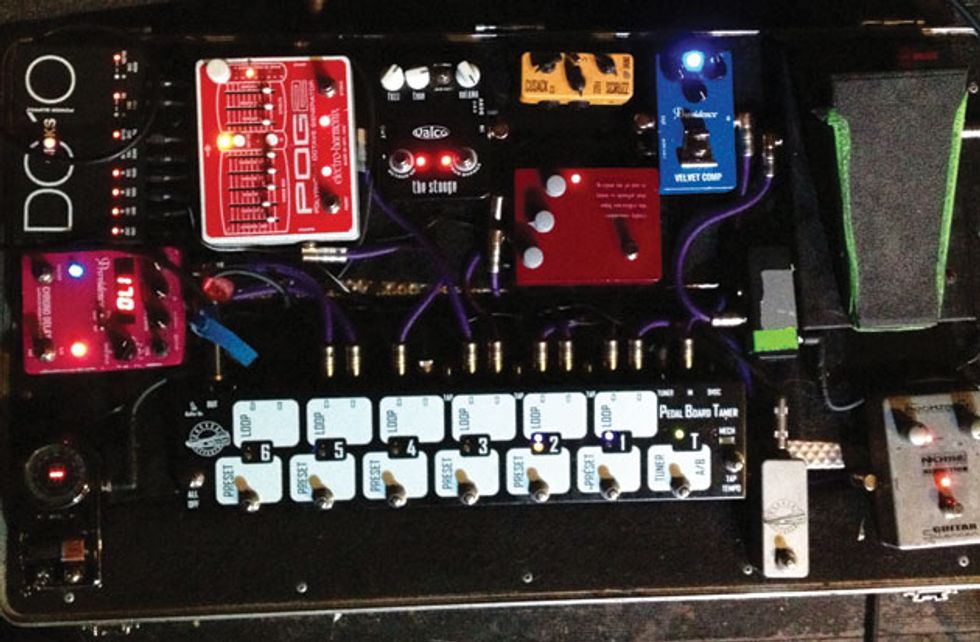








![Rig Rundown: Russian Circles’ Mike Sullivan [2025]](https://www.premierguitar.com/media-library/youtube.jpg?id=62303631&width=1245&height=700&quality=70&coordinates=0%2C0%2C0%2C0)





